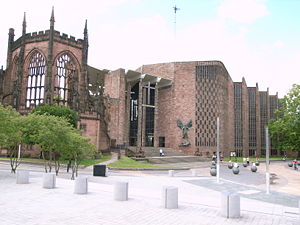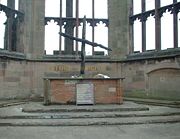Coventry Cathedral
| Coventry Cathedral | |

The old and new Cathedrals |
|
| Basic information | |
|---|---|
| Location | Coventry city centre |
| Full name | Cathedral Church of St. Michael |
| County | West Midlands |
| Country | England |
| Ecclesiastical information | |
| Denomination | Church of England |
| Province | Canterbury |
| Diocese | Coventry |
| Diocese created | 1095-1102; 1918- |
| Bishop | Christopher Cocksworth |
| Dean | John Irvine |
| Website | www.coventrycathedral.org.uk |
| Building information | |
| Previous Cathedrals | 2 |
| Dates built | 1956-1962 |
| Year consecrated | 1962 |
| Architect(s) | Basil Spence |
| Architectural style | Modernist |
Coventry Cathedral, also known as St Michael's Cathedral, is the seat of the Bishop of Coventry and the Diocese of Coventry, in Coventry, West Midlands, England. The current (9th) bishop is the Right Revd Dr Christopher Cocksworth.
The city has had three cathedrals. The first was St. Mary's, a monastic building, only a few ruins of which remain. The second was St Michael's, a Church of England church, later designated Cathedral, that remains a ruined shell after its bombing during the Second World War. The third is the new St Michael's Cathedral, built after the destruction of the former and a celebration of 20th century architecture.
Contents |
Cathedral Chapter
- Dean of Coventry - The Very Revd. John Irvine
- Precentor - The Revd. Canon Adrian Daffern
- Canon for Mission - The Revd. Canon Yvonne Richmond
The Revd. Canon Anthony Darby was previously Canon Theologian; however, he has now retired.
Honorary Canons
- The Revd. Canon Jim Canning
- The Revd. Canon Gillian Sanderson
- The Revd. Canon Dennis Sneath
St Mary's Priory
The first cathedral in Coventry was St Mary's Priory and Cathedral, which held such status from a date between 1095 and 1102, when the infamous Bishop Robert de Limesey moved the Bishop's see from Lichfield to Coventry, until 1539 when it fell victim to King Henry VIII's Dissolution of the Monasteries. Prior to 1095, it had been a small Benedictine monastery (endowed by Earl Leofric and Lady Godiva in 1043), but shortly after this time rebuilding began and by the middle of the 13th century it was a cathedral of 425 feet in length and included many large outbuildings. Leofric was probably buried within the original Saxon church in Coventry. However, records suggest that Godiva was buried at Evesham Abbey, alongside her father confessor, Prior Aefic.
St Michael's Cathedral
First structure

St Michael's church was largely constructed between the late 14th century and early 15th century. It was the largest parish church in England when, in 1918, it was elevated to cathedral status on the creation of Coventry Diocese. This St Michael's Cathedral now stands ruined, bombed almost to destruction during the Coventry Blitz on 14 November 1940 by the German Luftwaffe. Only the tower, spire, and the outer wall survived. The ruins of this older cathedral remain hallowed ground.
Present structure

The new St Michael's Cathedral, built next to the remains of the old, was designed by Basil Spence and Arup, built by John Laing[1] and is a Grade I listed building.
The selection of Basil Spence for the work was a result of a competition held in 1950 to find an architect for the new Coventry Cathedral; his design was chosen from over two hundred submitted.
Spence (later knighted for this work) insisted that instead of re-building the old cathedral it should be kept in ruins as a garden of remembrance and that the new cathedral should be built alongside, the two buildings together effectively forming one church. The use of Hollington sandstone for the new Coventry Cathedral provides an element of unity between the buildings.
The foundation stone of the new cathedral was laid by the Queen on 23 March 1956. It was consecrated on 25 May 1962, on the same day as the new Kaiser Wilhelm Memorial Church in Berlin, and Benjamin Britten's War Requiem, composed for the occasion, was premiered in the new cathedral on 30 May to mark its consecration.

Like its German counterpart in Berlin, its modernist design caused much discussion, but on opening to the public it rapidly became a hugely popular symbol of reconciliation in post-war Britain. The unconventional spire (known as a flèche) was lowered onto the flat roof by helicopter. The interior is notable for a large tapestry of Christ, designed by Graham Sutherland, the emotive sculpture of the Mater Dolorosa by John Bridgeman in the East end, and the Baptistry window by John Piper, of abstract design that occupies the full height of the bowed baptisery, which comprises 195 panes, ranging from white to deep colours. The other stained glass windows, by Keith New, are generally regarded as less successful. Also worthy of note is the Great West Window known as the Screen of Saints and Angels, engraved directly onto the screen in expressionist style by John Hutton. (Although referred to as the West Window, this is the 'liturgical west' opposite the altar which is traditionally at the east end. In this cathedral the altar is actually at the north end.)The foundation stone, the ten stone panels inset into the walls of the cathedral called the Tablets of the Word, and the baptismal font were designed and carved by the emigre German letter carver Ralph Beyer.
Theological emphasis

Being built on the site of a Benedictine monastery, there has always been a gentle Benedictine influence on the Cathedral Community. A number of the Cathedral staff become third order (lay) Benedictines and there are often Cathedral retreats to Burford Priory. Since the opening of the new Cathedral in 1962 there has been a gentle evangelical emphasis. This has been strengthened by the current Dean John Irvine who was involved in creating the Alpha Course and previously worked for Holy Trinity Brompton. The Cathedral has a strong emphasis on the Bible and aims to be a centre for good preaching and training for the diocese. It runs regular mission events headed by residentiary Canon Yvonne Richmond (one of the only Canons for Mission in the UK with such a strong focus on evangelism) such as the innovative Spirit of Life days where over 2000 local residents are encouraged to explore their faith in God through Christian spirituality. The Cathedral is also known for its innovation in its services. As well as the expected traditional services, there is a 6 p.m. service with contemporary music, preaching and prayer ministry. The Cathedral Youth Work runs Goth church and Urban Church outreach congregations for local groups of young people, an equipping and supporting cell group for youth workers within Coventry churches as well as a number of other regular groups. There continues to be a strong influence of reconciliation within the theology (both vertical - reconciling people to God and horizontal - reconciling individuals and groups). This is present throughout the ministry of the cathedral but is most clearly seen in the International Center for Reconciliation and the International Network of Communities of the Cross of Nails. The reconciliation work exists locally in reconciling churches and community groups but also internationally (predominantly in the Middle East and central Africa) working with terrorists and dictators as well as local churches, tribes and gangs.
Wooden Cross and Cross of Nails


Gemarke Church Wuppertal, Germany
The wooden cross and the cross of nails were created by Provost Richard Howard of Coventry Cathedral after the cathedral was bombed during the Coventry Blitz of World War II. He saw two wooden beams lying in the shape of a cross and tied them together. A replica of the wooden cross has remained in the ruins of the old cathedral since the 1970s.
Another cross was made of three nails from the roof truss of the old cathedral. It was later transferred to the new cathedral, where it rests on its altar. The cross of nails has become a symbol of peace and reconciliation across the world. There are over 160 Cross of Nails Centres all over the world, all of them bearing a cross made of three nails from the ruins, similar to the original one.
One of the crosses made of nails from the old cathedral was donated to the Kaiser Wilhelm Memorial Church in Berlin, which was destroyed by Allied bomb attacks and is also kept as a ruin alongside a newer building. A copy of the Stalingrad Madonna by Kurt Reuber that was drawn in 1942 in Stalingrad (now Volgograd) is shown in the cathedrals of all three cities (Berlin, Coventry and Volgograd) as a sign of the reconciliation of the three countries that were once enemies.
A medieval cross of nails has also been carried on board all British warships to subsequently bear the name HMS Coventry. The cross of nails was on board HMS Coventry when she was sunk by enemy action in the Battle of the Falklands. The cross was salvaged by Royal Navy divers, and presented to Coventry Cathedral by the ship's Captain and colleagues. (One Hundred Days, Admiral Sandy Woodward.)
A 1962 BBC documentary on Coventry Cathedral, its destruction and rebuilding, narrated by Leo Genn, was broadcast on British television.
Music
Organ
The cathedral has a pipe organ by Harrison and Harrison dating from 1962. A specification of the organ can be found on the National Pipe Organ Register.
Directors of music
|
|
Head choristers
- Girls' choir - Natilie Parr
- Boys' choir - Tom Flowers
Gallery
Trivia
- To Say Nothing of the Dog (1997), a Hugo Award-winning novel by Connie Willis, centres around an effort to rebuild the second cathedral in 2057.
References
See also
- List of cathedrals in the United Kingdom
External links
- The cathedral's official website
- Further reading about Coventry's three Cathedrals
- Virtual tour of both the new cathedral and the ruins
- The Cross of Nails website
- Flickr images tagged Coventry Cathedral
- Details of the organ from the National Pipe Organ Register
- Photograph of interior prior to destruction
- Images of England — details from listed building database (218629)
|
||||||||||||||||||||||||